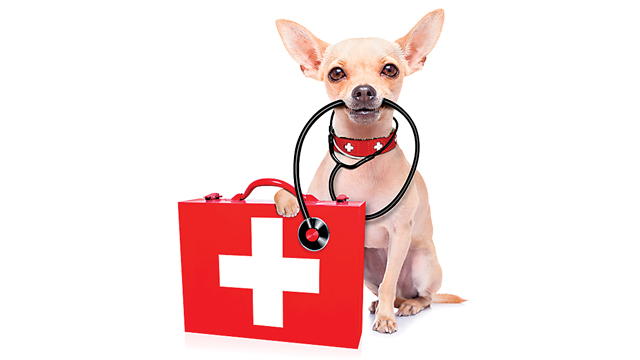Our family recently enjoyed a wonderful vacation on a fairly remote beach. We loved having no phones, sleeping late, and seeing nobody else on our beach. However, as I was exploring and photographing the sunrise one morning, I stepped on something sharp and cut my foot. I had packed a small first aid kit and was fixed up and back on the beach in no time. But this got me thinking about my silly, lovable Labrador retriever, Wyoming, who believes all things are edible and all spaces can contain his seventy-five pounds. What would I want in my first aid kit if I were on a remote beach, or even at home with my goofy boy?
Dogs are prone to the same dangers and injuries that we encounter, so having a pet first aid kit is a great idea. It should contain the basics: gauze squares, gauze rolls, medical tape, tweezers, small scissors (to cut bandages), and a pet thermometer. Add a flashlight and magnifier so you can see what you are doing in small furry spaces. Stash an extra leash in there, and have a list consisting of your veterinarian’s phone number and the closest veterinary emergency center. The 24-hour national ASPCA Animal Poison Control number is 888-426-4435. There is a fee for this consultation, but the information they provide is specific for your pet and circumstance, and it can be life-saving. Finally, include a bottle of hydrogen peroxide, and if your vet approves, some diphenhydramine tablets (an antihistamine).
First aid is the first step toward helping your pet in the event of illness or injury. However, first aid should always be followed up with professional care. Contact a veterinarian as soon as possible to determine if additional care and treatment are needed.
1. Bleeding from cuts, scrapes, and torn toenails is a common occurrence, especially in more active months when we are out hiking and playing with our dogs.
In the event of bleeding, place clean gauze or cotton bandaging over the area and hold firmly. Be generous with the gauze! It can take several minutes for an adequate clot to form. It is better to hold the bandage in place, watching the clock instead of the wound. Wait for five minutes before you peek under the bandage to see if the bleeding stopped. If the blood soaks through your gauze bandage, don’t remove it, just add more gauze and keep holding pressure for the five minutes. Once the bleeding has stopped, you can place clean gauze over the wound and tape it into place without pressure.
2. Accidental poisoning happens because a dog explores the world with his mouth and nose, and eats just about anything.
Common poisons or toxins include human medications (prescription and over the counter), some plants, pesticides, household cleaners, and some foods such as chocolate. It is important to contact your veterinarian and/or call ASPCA Animal Poison Control as soon as a possible poisoning is suspected. Have as much information as you can about what your dog has eaten. The severity of the intoxication depends on the dose your dog received. Your pet’s current weight and the amount of substance eaten will be very important to determine appropriate treatment. Any remains of the eaten items, such as chewed up packaging, will provide good information about what and how much might have been consumed. If your pet has vomited, note how much and what has been vomited. A photo and a sample will be helpful. Sometimes inducing vomiting is the appropriate treatment for a poisoning. Hydrogen peroxide can be used for this purpose. However, the induction of vomiting should only be done at the direction of a veterinarian or poison control professional. Never induce vomiting in a pet that is weak, unconscious, or having trouble breathing.
3. Bites, stings, and allergic reactions are a part of a pet’s life, too.
Check with your veterinarian first, but diphenhydramine is safe for almost all dogs and is an inexpensive addition to your first aid kit. It can relieve some of the uncomfortable symptoms of stings and allergies. If you see a stinger on your pet, use a credit card to scrape it out and off. Local pain and swelling can start immediately, so if you are prepared with the right dose of diphenhydramine, you can give your pet some relief even while on your way to the veterinarian.
Hopefully, you and your pet will never experience it, but some situations are life threatening and require an immediate trip to the veterinarian. These include severe bleeding, trouble breathing, eye injuries, inability to urinate or defecate, broken bones, or unconsciousness. It is possible to perform CPR on a pet that is not breathing, choking, or in cardiac arrest. Success rates are low, unfortunately, but the techniques are easy to learn and perform. The AVMA (American Veterinary Medical Association) has information on their website avma.org and a video on YouTube (search for AVMA TV: CPR for Pets).
Remember that an injured pet may be frightened and confused. In this situation, even a sweet, gentle pet may bite. Placing a muzzle around the pet’s mouth will keep you safe while you are administering first aid. Grab that extra leash in your kit, and place it over the dog’s nose, cross the ends under his chin, and then tie it behind the ears. Be sure the dog can get plenty of air through the nostrils. Never muzzle a dog that is vomiting, overheated, or having trouble breathing. Keep yourself safe so you can keep your pet safe and administer first aid.





